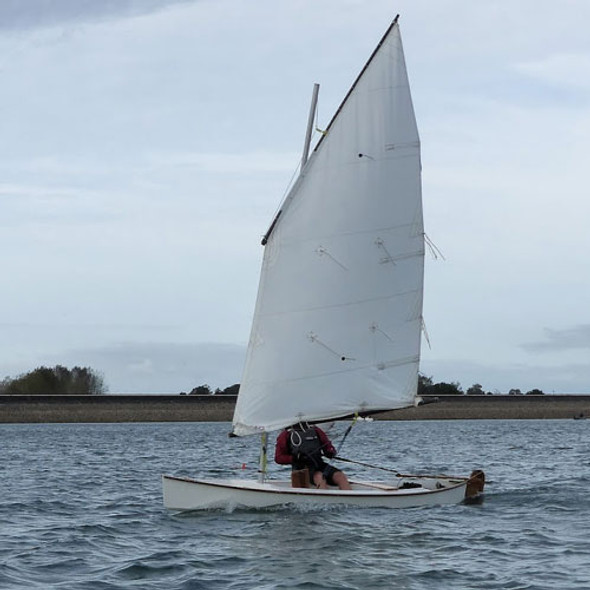Description
Canoe Sail 36 sq ft (3.34 sq m)
We are happy to announce the introduction of a modest sailing canoe sail.
It is also suitable for small children's sailing dinghies about 8ft long - see more information below. Typically kids sailing dinghies have around 35 to 40 square feet of sail.

The production sail has only a single reef unlike this early trial sail from a couple of years ago.
The photos are the same sized sail made by my friend Paul Helbert on prototype Quick Canoe being sailed by me at Mt Storm Reservoir in Virginia USA. The new RSS made sail is quality white dacron and has one reef only, but these photos should give an estimate of the size and how it looks.

It will fit many boats including the drop in sailing canoe rig from Storer boat plans. It has a reef that will take it down to 23 sq ft which is the same size as the original smaller sail for the drop in rig. It uses the same yard and boom length as that simple sailing rig.
Fitting the 36sq ft sail to other boats and canoes.
Mast Diameter - We recommend for canoes where the crew might sit on the side of the boat to sail that the mast cross section be around 50mm (2") round or 45mm (1 3/4") square with rounded corners. The round dimensions will work for round wooden masts, including hollow birdsmouth mast construction or for an aluminium section with about a 2mm (.08") wall.
For a boat which will be sailed sitting inside the boat I would recommend a mast slightly smaller. You can deduct 6mm or 1/4" from the mast diameter.
Mast Length - The mast needs to extend be about 2560 above the deck or sheerline of the boat, but will need to be longer to reach the bottom of the boat.

Other Spars and Centre of Effort or balance of the boat
This is a sail diagram to give the measurements for the yard and boom. It also gives enough information for people to work out if the CE (centre of effort) will be in the right place for their centreboard or leeboard position.

As a balance lug - For a boat without a skeg or keel I usually use the underwater part of the centreboard or leeboard ignoring the rest. Then I take the middle leading (front) edge as the point I am interested in. If that point is about 400mm (1.3ft) behind the mast or LESS then this sail should work.
As a standing lug - If it is used as a standing lug rather than a balance lug the leading edge of the board can be 700mm behind the mast.
Rigging the sail
One of the best pages for rigging lug sails is on the storerboats website, but rope sizes can be much less than shown for the larger Goat Island Skiff.
An Example of Alternative Boats
Dave Gentry, who designs very fast building skin on frame boats designed a lightweight dinghy (55lbs/25kg) around this canoe sail. Dave has set it as a standing lug.
More on Dave's Piankatank River Pram here
Articles about RSS Sails
Using Really Simple Sails on other boats. Advice and dimensions
First live firing of Really Simple Sails for GIS
PDF with sail details on GIS and OZ sails:
More info on the Canoe Sail:







